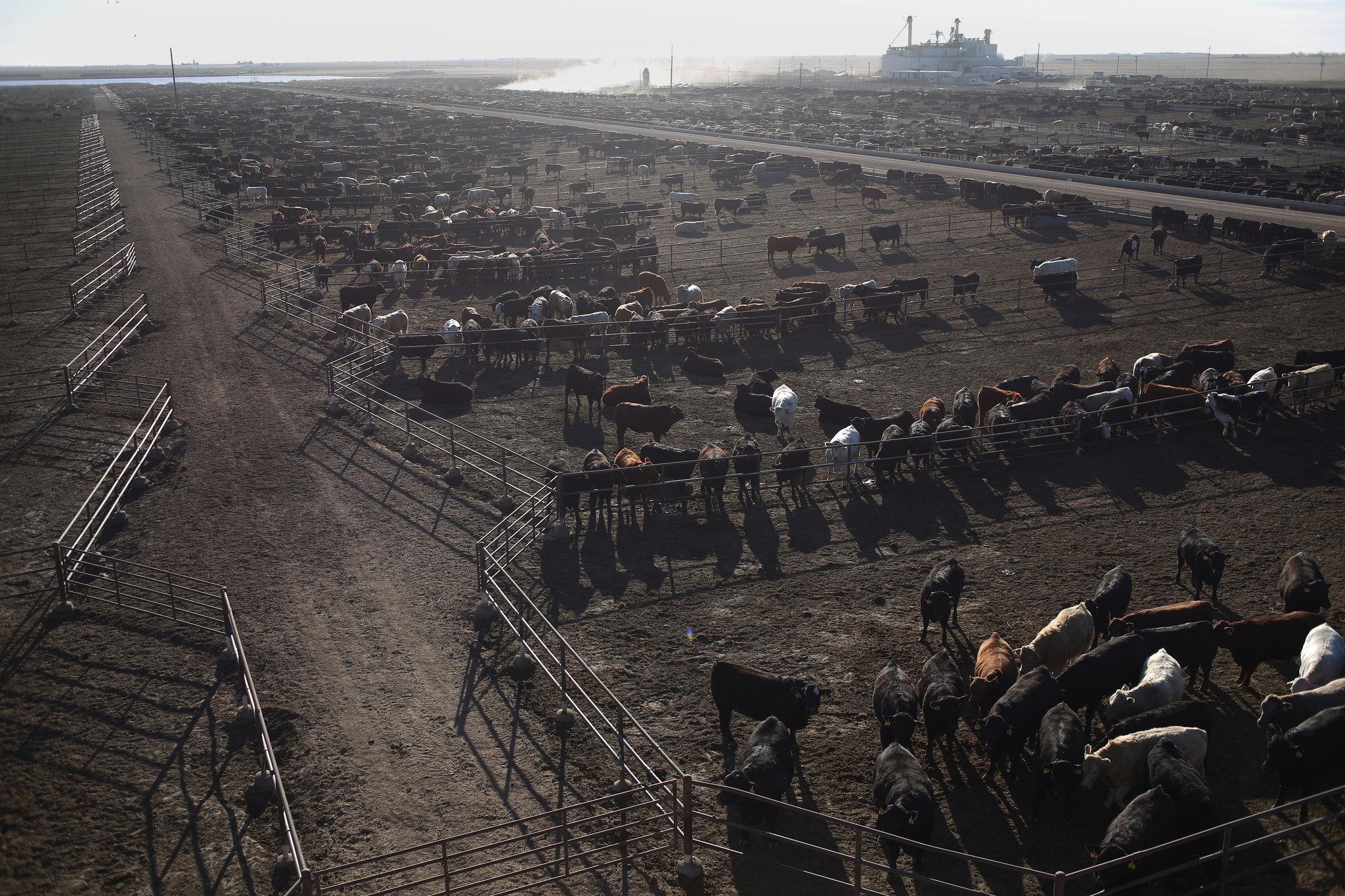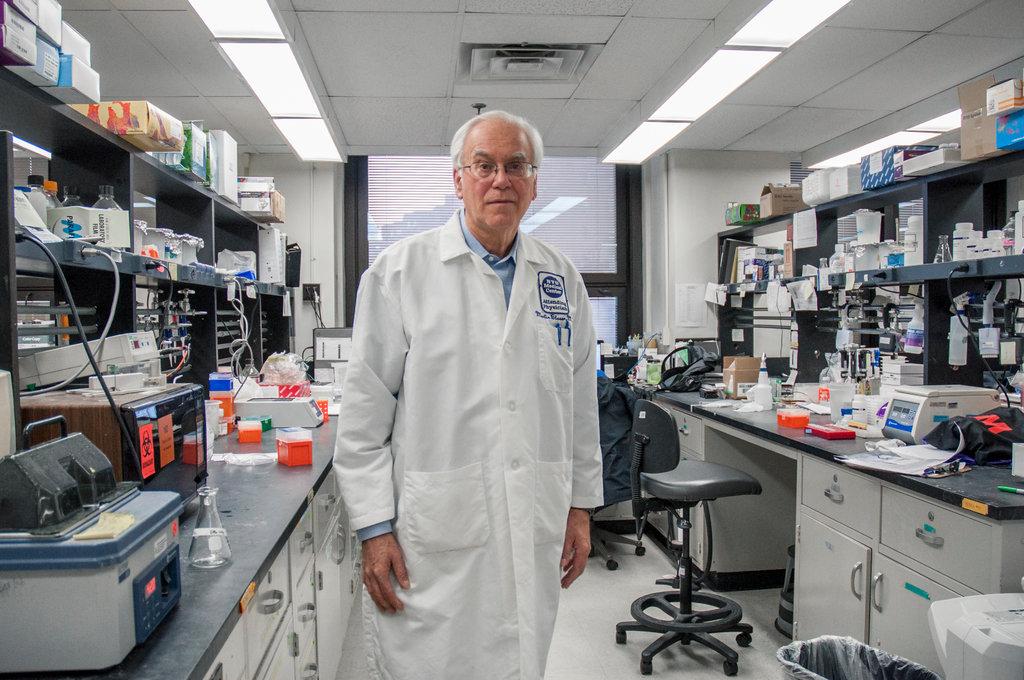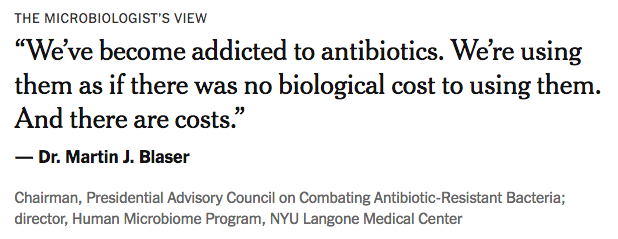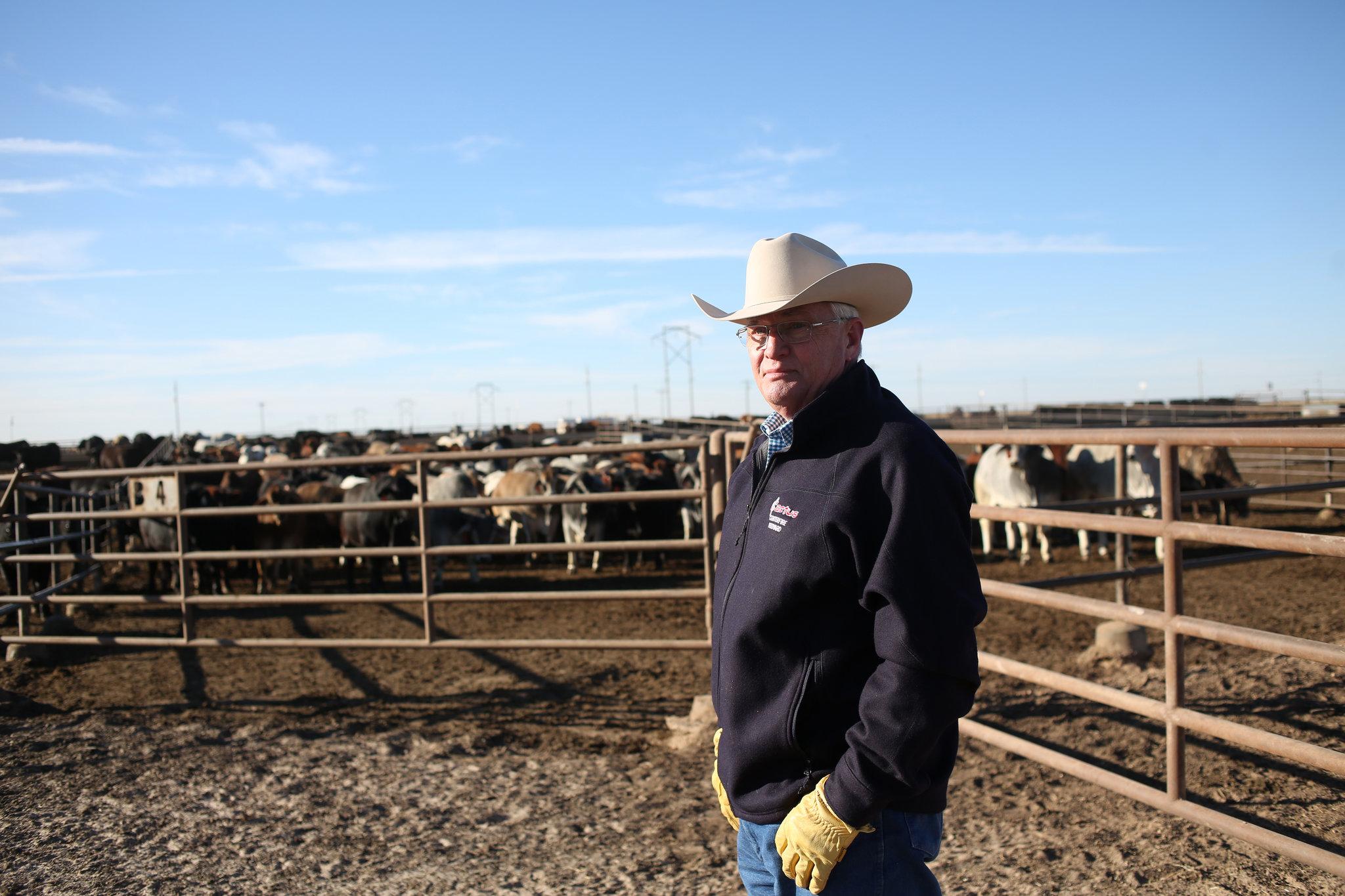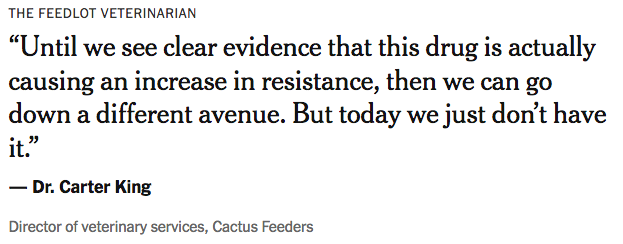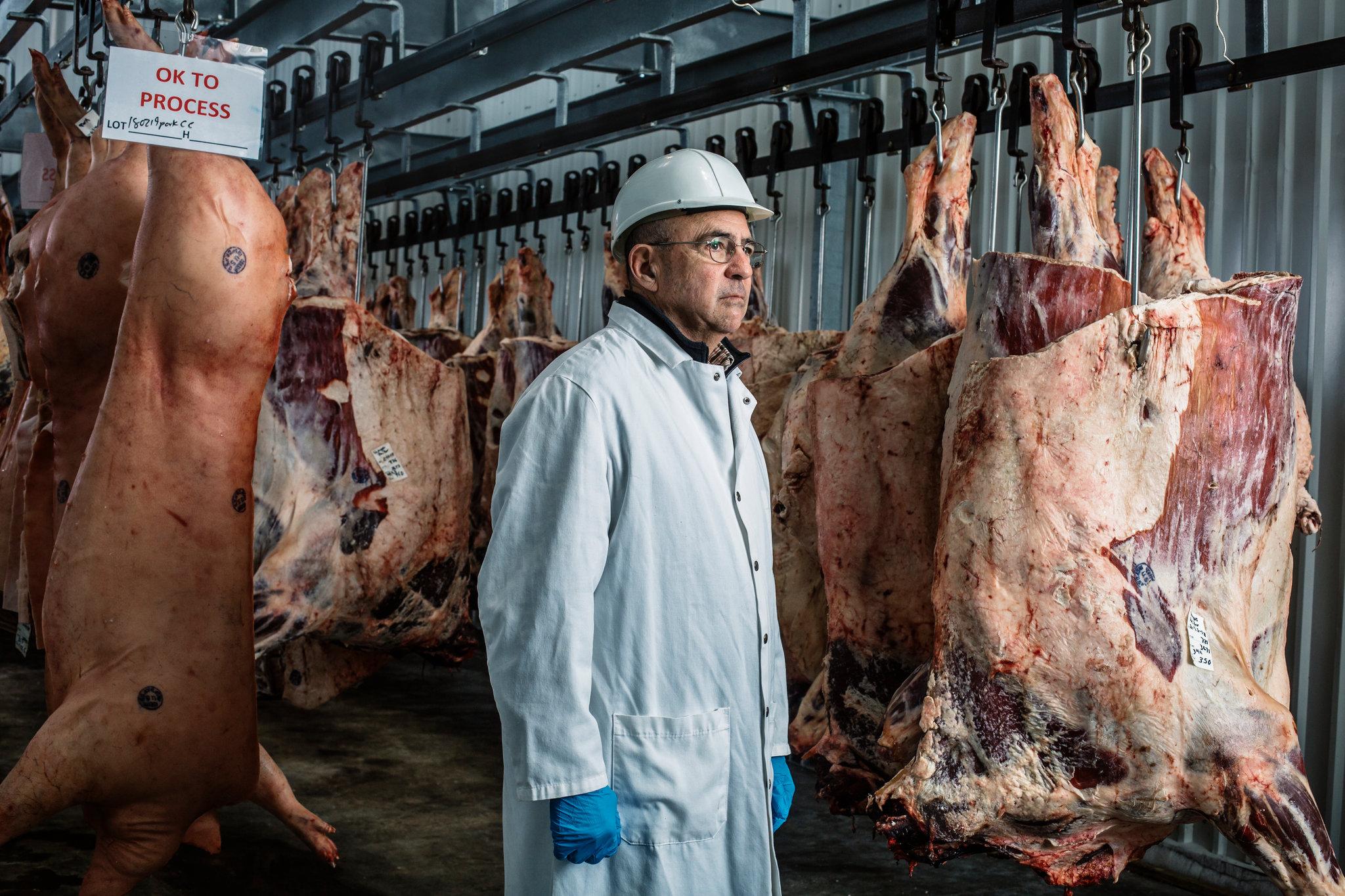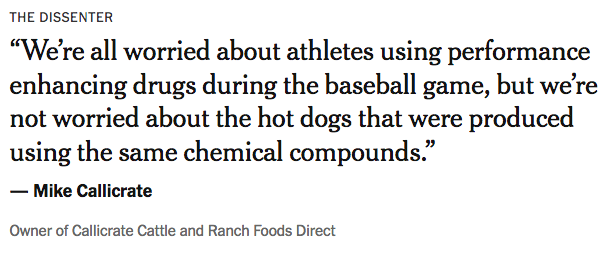Many industrial feedlots see routine use of antibiotics as essential. Some cattlemen disagree, calling them “performance enhancing drugs.”
By Danny Hakim | March 23, 2018
Ben Holland holds a Mason jar, tilting it slightly to show the powdery 90 milligrams of the antibiotic tylosin inside.
“It’s about the amount that one animal gets in a day,” he explains, in a small factory that produces feed for 48,000-odd cattle packed in pens in Tulia, Tex., south of Amarillo. Nearby, rumbling steam towers turn corn kernels into flakes.
Dr. Holland is the director of research at Cactus Feeders, a feedlot giant. During a recent visit, I found myself surrounded by men with Ph.D.s and cowboy hats like Dr. Holland. Several wore jackets bearing drug company logos that were sure to smell of steamed corn and flatulent cattle by day’s end.
Behind Dr. Holland, antibiotics were stacked in large bags rising to his shoulders. Every day, cattle here, whether sick or healthy, are given antibiotics in their feed.
But it’s an increasingly debated practice on industrial farms.
Bacteria resistant to antibiotics turn up in turkey, pork chops and ground beef in the United States; in grocery store chickens in Britain; and at poultry farms in China. Antibiotic residues are found in groundwater, drinking water and streams, and in feedlot manure used as fertilizer.
Some 70 percent to 80 percent of American antibiotic sales go to livestock. In addition to the emergence of resistant disease strains, some microbiologists worry that the proliferation of antibiotics, despite their miraculous health benefits, is having a chaotic impact on microbes in the human gut.
The Cactus feedlot is hamburger central, the middle passage of cattle’s industrial journey. Calves come from farms to be fattened up on corn and grain for several months, and then are shipped out for slaughter and processing.
Cattle, however, evolved to eat grass, and their time on a feedlot causes health complications. Hence the antibiotics. Tylosin controls liver abscesses, and Rumensin, another antibiotic feed additive, fights intestinal disease.
While Cactus has taken steps to limit the use of such drugs, it sees cheap and plentiful hamburgers and steaks as a byproduct of industrialization.
“We’ve got to take that potential value and balance it against the risk,” said Paul Defoor, co-chief executive of Cactus. “Antibiotic resistance is a fact of life, no two ways about it,” he added. “We want to make sure that by virtue of our using these products we’re not contributing to it.”
Others, however, see the risk far outweighing the reward.
Dr. Martin J. Blaser, a white-haired scientist in a V-neck sweater and black Mephisto sneakers, walked me through his lab recently at a Veterans Affairs hospital in Manhattan.
“Both on the farm and in human medicine, we’ve become addicted to antibiotics,” he said. “We’re using them as if there was no biological cost to using them. And there are costs.”
Regular use of tylosin on farms, he added, “is a genuinely bad idea because of cross-resistance, involving important drugs used in human medicine.” Tylosin is part of a widely used class of antibiotics used by humans, including Z-Pak.
But Dr. Blaser’s career has largely been focused on a less talked about symptom of the proliferation of antibiotics: tracking disappearing microbes in the human gut.
We moved down the aisle of his lab, amid a jumble of computer screens and rows of lab desks, beakers, binders and pipettes. Dr. Blaser introduced a cadre of assistants. Many were connecting specific diseases to the disappearance of particular gut microbes, often due to antibiotics.
“Tim here, who’s a graduate student, he works on asthma,” Dr. Blaser said. Another is “running a very big project” on juvenile diabetes.
A visiting Chinese scholar studies obesity and antibiotics. Two more researchers, Dr. Blaser said, are looking at “an organism that many people have in their gut that may be protective against kidney stones.”
Some microbes are misunderstood. Take Helicobacter pylori, a passenger in the human gut for thousands of years linked in the last century to certain cancers.
“Because of ulcer and stomach cancer, doctors, mostly gastroenterologists, said we should just get rid of H. pylori from everybody,” Dr. Blaser said. “But I began to think differently.”
Research from the National Cancer Institute published in January found a potential downside to its disappearance, linking its loss to a new gastric cancer more likely in younger patients and women.
“Nature abhors a vacuum, and if Helicobacter, which was dominant, is gone, something is replacing it, or some things are replacing it, and that has consequences,” Dr. Blaser said.
Scientists like Dr. Blaser worry that we are too often exposed to antibiotics, beyond when we actually need them. But the United States has resisted more aggressive restrictions on livestock antibiotics that countries like the Netherlands have taken. As of last year, the Food and Drug Administration barred meat producers from using antibiotics to increase the growth of animals, rather than to treat disease. Veterinary prescriptions are now required for farm antibiotics.
But the new rules were designed in cooperation with drug companies and industrial farm groups.
“That didn’t affect us,” Mr. Defoor of Cactus said of the ban. Similarly, Zoetis, a major livestock drugmaker, said on its website that farmers “will see little difference” in its tetracycline feed additives, beyond needing the appropriate paperwork from veterinarians.
But demand for antibiotic-free meat is eclipsing regulation. Annual sales of antibiotics for farm animals fell 10 percent in 2016, before the F.D.A.’s new policy began.
Dr. Blaser turned reflective. In his office, a colorful pinwheel maps the microbial population of his poop.
“It’s just like global warming,” he said of modern changes to our internal microbiology. “It’s a big ecological shift, except it’s happening within the human body.”
“There’s a pen up here I’ve been wanting to look at.”
Dr. Carter King oversees 10 feedlots for Cactus and some two million head of cattle a year. It was before 8 a.m., and he was guiding a Toyota Tundra pickup truck around the feedlot, his wallet resting on a blue bandanna on the center console. Cowboys roamed on horseback, trained by Dr. King as medics, alerting him to trouble.
The work is not for everyone.
“We’ve tried taking guys that came off a ranch somewhere, and you put them in a pen of cattle on a feed yard and a lot of times it doesn’t work,” Dr. King said. “They’re used to green grass and trees, and cows standing under trees in the open air, and a feed yard is an adverse, harsh place to work.”
He stopped the truck. Smoke plumed from the distant tower where corn is flaked. He pointed to a smoky-colored calf.
“That calf doesn’t feel good,” Dr. King said. “He’s by himself. He’s just kind of standing there. He’s a little drooped.” He motioned to nearer calves coming forward to investigate. “You look at these calves here, they’re alert — they’re looking at us trying to figure out what we are.”
Dr. King was “raised on a ranch out in the middle of nowhere.” He has had his own veterinary practice, and has worked for the drugmaker Upjohn and even at a zoo, where he learned to wake up gorillas anesthetized by blow darts. (“You pull his tongue over his nose, and you insert the needle into that vein.” And then bolt.)
Early in his career, a large cattle business asked Dr. King to prescribe a banned antibiotic. He knew he was “going to blow this opportunity because I’m going to tell this guy, ‘No,’” he said. He did, and lost a customer.
Still, Dr. King and other industry veterinarians support using antibiotics in feed. Keith E. Belk, a Colorado State University professor who works closely with the beef industry, said research on risks like liver abscesses was more uncertain than many studies suggested. And “the industry has a whole lot of research to find substitutes,” he added.
Especially in chickens. Zoetis said last year that its “portfolio of alternatives to antibiotic medicated feed” was “the primary driver of growth” in poultry.
For now, the view from the feedlot is that the risks are not evident enough to stop using drugs like tylosin.
“Until we see clear evidence that this drug is actually causing an increase in resistance, then we can go down a different avenue,” Dr. King said. “But today we just don’t have it.”
A blunt-spoken former bull rider, Mike Callicrate raises cattle in Kansas and Colorado. To him, antibiotics are “performance enhancing drugs,” and he lumps them in with other industrial additives like steroid hormones.
“We’re all worried about athletes using performance enhancing drugs during the baseball game, but we’re not worried about the hot dogs that were produced using the same chemical compounds and that are being eaten by our children,” he said during a recent visit to his farm on the Kansas-Colorado border.
This is not to say he refuses all antibiotics. He uses them to treat sick cattle, but does not mix them into feed for healthy calves.
“We need the tool when we need the tool, but the fact is we’ve overused the tool to offset the negatives of industrial production,” he said.
Mr. Callicrate took me around his farm, a bucolic vision of grazing cattle and open fields. He’s an outspoken guy, who calls the feedlot giant JBS the “rotten meat mafia,” attacks industrial practices on his website and once sued the government to protest the management of a nationwide program to promote beef.
He gave up on the industrial production model years ago, and now has a small operation that encompasses all steps of the business, from birth to slaughter to a retail meat counter in Colorado Springs.
“We can litigate, we can legislate, but who’s building the alternative?” he asked during lunch over chipped beef in downtown St. Francis, Kan. “So I felt compelled. I’ve got to build the alternative. I can’t be such a loudmouth and such a critic of this existing system without giving people an alternative.”
Still, it is difficult to buck the system and make a buck. Agriculture is now built around the industrial model. Mr. Callicrate has the luxury of raising cattle the way he does because he invented a contraption to castrate bulls humanely.
“This makes money,” he said, while he showed me how to cinch a bull’s testicles in the Callicrate Bander, which looks like a slingshot crossed with a fishing rod. “Everything else loses money.”
Antibiotic-free beef also costs consumers more, though groups like Consumers Union feel it “is worth the extra money.”
For Mr. Callicrate, keeping his cattle off the feedlot changed his perspective.
“I’ve decided to take a different path, slow down a little bit,” he said. “If I have to be responsible for the steak on the plate, I’m going to change the way I’m producing it.”
Danny Hakim is an investigative reporter for the business section. He has been a European economics correspondent and bureau chief in Albany and Detroit. He was also a lead reporter on the team awarded the 2009 Pulitzer Prize for Breaking News. @dannyhakim Facebook
RELATED from News.MikeCallicrate.com: New York Times: Antibiotics in Meat Could Be Damaging Our Guts

